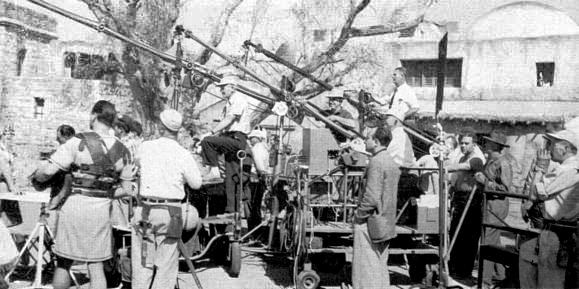STEREOPHONIC SOUND
calls for three dolly mounted
microphones, whose shadows must be flooded out with
special lighting. Twentieth Century-Fox is testing the
comparative |
quality of multiple sound tracks on the picture film, and
independent sound tracks which would be synchronized in
theater projection booths.
|
with another anamorphic lens and presto - Burl
Ives expands to his proper proportions,
flanked by a breathtaking setting half a city
block wide!
 Not since Al Jolson opened his mouth to
fill American flicker houses with
synchronized sound, has science offered the
movie industry anything so charged with
entertainment possibilities as this amazing
peripheral-vision lens developed in 1937 by a
modest French scientist named Henri
Chretien. Not since Al Jolson opened his mouth to
fill American flicker houses with
synchronized sound, has science offered the
movie industry anything so charged with
entertainment possibilities as this amazing
peripheral-vision lens developed in 1937 by a
modest French scientist named Henri
Chretien.
 In a neat housing hardly larger than a king size pack of cigarettes, the anamorphic lens
produces a wide-screen picture comparable
in size to the image achieved by Cinerama.
But unlike Cinerama, Cinemascope
(Twentieth Century-Fox's trade name for
anamorphic productions) has no disturbing,
filmlapping edges, no change of color
values. In a neat housing hardly larger than a king size pack of cigarettes, the anamorphic lens
produces a wide-screen picture comparable
in size to the image achieved by Cinerama.
But unlike Cinerama, Cinemascope
(Twentieth Century-Fox's trade name for
anamorphic productions) has no disturbing,
filmlapping edges, no change of color
values.
Different from Wide-Screen Classics
 Don't confuse Cinemascope with so-called
wide-screen classics now going the rounds
of the larger metropolitan theaters. Unlike
Cinemascope, they are narrowed - down,
conventional films. Don't confuse Cinemascope with so-called
wide-screen classics now going the rounds
of the larger metropolitan theaters. Unlike
Cinemascope, they are narrowed - down,
conventional films.
|
Quick change artists have
simply placed a shadow mask behind the film track of a
standard projector, then spread the image
with a wide-angle lens.
 Apart from scalping the actors and
chopping their legs off at the thighs, it also
magnifies the film grain to the atom-smashing
point, giving fair-faced starlets more freckles
than Arthur Godfrey. Apart from scalping the actors and
chopping their legs off at the thighs, it also
magnifies the film grain to the atom-smashing
point, giving fair-faced starlets more freckles
than Arthur Godfrey.
 Cinemascope, too, must be magnified. But
because the height of the image has not been
reduced by the anamorphic lens, the grain
appears on the screen in the form of barely
noticeable microscopic horizontal threads. Cinemascope, too, must be magnified. But
because the height of the image has not been
reduced by the anamorphic lens, the grain
appears on the screen in the form of barely
noticeable microscopic horizontal threads.
 But the real impact of Cinemascope will
come from brand-new technical tricks and
radical changes in film directing. If you have
seen Cinerama you know how wide-screen
productions can engulf you in a Technicolor
arc charged with breathtaking action, beauty
and stereophonic sound. That two-hour
assortment of shorts used every ocular and
audio gimmick of the trade to chill and thrill
you.
But the real impact of Cinemascope will
come from brand-new technical tricks and
radical changes in film directing. If you have
seen Cinerama you know how wide-screen
productions can engulf you in a Technicolor
arc charged with breathtaking action, beauty
and stereophonic sound. That two-hour
assortment of shorts used every ocular and
audio gimmick of the trade to chill and thrill
you.
 Cinemascope must do more. To take a
permanent place in the entertainment world,
it must make you forget that it Cinemascope must do more. To take a
permanent place in the entertainment world,
it must make you forget that it
Continued
|
